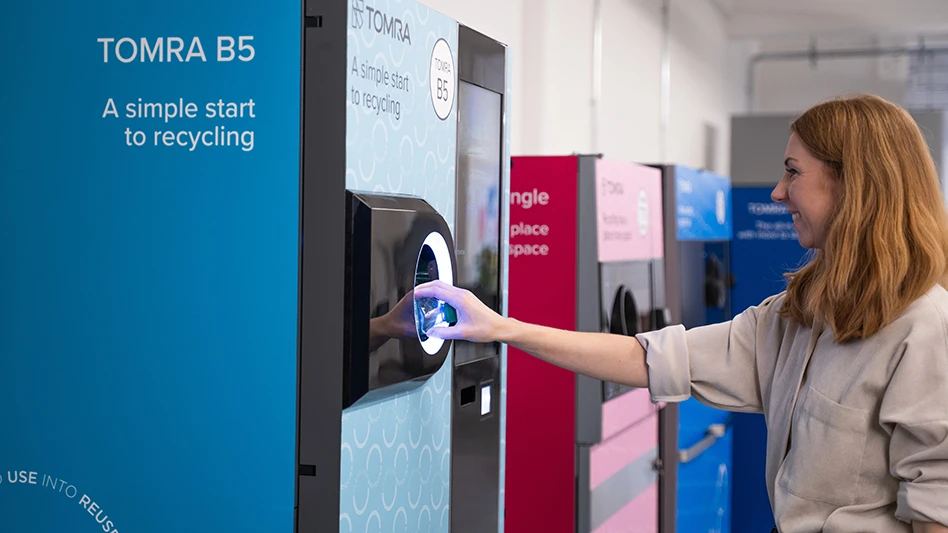But they weren't built from redwood or cedar – or anything else that once grew in a forest. Each table was made from hundreds of old milk jugs that were chipped into tiny bits, melted and extruded into high-density boards.
Six months ago, Plastic Lumber Co. was hopping with activity as orders streamed in for tables, park benches, signs, waste receptacles and dozens of other products.
But it's a little quieter these days around the plant and offices, spread out in three adjoining buildings in the former B.F. Goodrich complex in downtown Akron.
The 14-year-old company, one of the darlings of Akron's effort to expand its polymer industry, is going through a rough patch. Orders for outdoor furniture nearly screeched to a halt in the second half of last year, as parks and recreation districts around the country began tightening their budgets.
Plastic Lumber's sales fell 6 percent for the year, to less than $6 million. That was an abrupt change for a company accustomed to years of double- and triple-digit growth. Just last year, Plastic Lumber ranked 87 on the Weatherhead 100 list, an annual listing of Northeast Ohio's fastest-growing companies. The Akron company had notched up sales growth of 101 percent over the past five years.
Founder and President Alan Robbins has laid off 15 workers since last summer, including a big chunk of his part-time, disabled work force. That has slimmed the payroll to fewer than 40 people.
“The slowdown actually took me by surprise,” Robbins said. “Our sales were up about 6 percent in the first two quarters (of 2002). But then orders started to fall off, and by mid-July, I realized it was getting serious.”
So he's taking steps to adjust, hoping they will help the company become more competitive.
He is adding more upscale products, such as contemporary-style benches and stylized latticework for gardens. He is updating some designs -- for example, making plastic signs and posts look more like granite. He's also spending tens of thousands of dollars to reconfigure the factory's production lines to double production and to buy a rotational molding machine to make a broader line of side products.
Meanwhile, Robbins is hitting the trade-show circuit, aggressively scouting out high-growth markets, such as spas, decking and decorative signs.
The goal, he says, is to find new opportunities during the slowdown in his largest market, parks and recreation products.
“We want to defend our old markets and improve them, like tables and benches,” Robbins said. “But if you don't stay innovative with new products, even when times get tough, then you just have to hunker down and skinny down your work force to the fewest number of people and try to push productivity. And you can't do that forever and succeed.”
Some people who have known Robbins for years are betting he can overcome the business setback and keep thriving.
“Alan knows where to go,” said Ron Clark, president and executive director of the Ohio Polymer Enterprise Development Corp. in Akron, a group that helps inventors and entrepreneurs develop new polymer-related businesses. “He just got caught in the lull of the economic slowdown and he has to regroup a little.”
Plastic Lumber Co. isn't the only one in the industry going through bumpy times. Its largest competitor, U.S. Plastic Lumber Corp. of Boca Raton, Fla., has lost money for the last two years, forcing it to cut hundreds of positions and close several factories. Its shares have fallen from $16 in 1999 to 22 cents last week.
Robbins said his company, by comparison, has always been profitable, but he declined to give figures. He says the company's long-term outlook is strong.
Plastics experts in the area say Robbins is the right man to keep the company moving in the right direction.
“He is the kind of guy, from my observation, who is well plugged-in and is constantly probing the opportunities,” said Frank Kelley, dean of the College of Polymer Science and Polymer Engineering at the University of Akron. “I know Alan is looking at ways to upgrade his product line with one of our professors here.... The markets are wide open for plastic lumber.”
U.S. demand for plastic and wood-plastic lumber is expected to nearly double between 2001 and 2006, from $1.07 billion to $1.95 billion in 2006, according to Freedonia Group, a Cleveland-based industry research firm.
All that plastic lumber will be used in a wide range of products, such as decks, fences, doors and window frames.
The industry says the big advantage is that plastic lumber can last years longer than wood without rotting or splintering, and is nearly maintenance-free. Those are big selling points for outdoor furniture, playground structures and boat docks.
Plastic Lumber Co. touts these benefits aggressively. Its catalogue is filled with such phrases as “splinter-free,” “no staining, no painting, no wood treatments,” and “you never need worry about splinters, rot or painting.”
But for all those benefits, plastic lumber is more expensive than traditional wood. Plastic Lumber does sell its sturdy products at bargain-basement prices. A 6-foot-long picnic table costs $439. A stylish, contoured park bench sells for $599. A backyard deck made of plastic lumber can cost 25 percent more than pressure-treated southern pine.
And plastic lumber isn't ideal for every use. It expands and contracts more than wood does, can weigh more than some types of wood, and isn't approved for structural purposes, such as the support beams of a deck or house.
The company was forced to replace plastic boards it sold for bleacher seating at the old Wooster High School after some of the boards expanded, contracted and snapped off.
Robbins said the problem occurred because the bleacher design called for the wrong size boards, without taking expansion and contraction into account.
“That was unfortunate, but we got it corrected,” Robbins said. “Neither one of us realized they were going to have that kind of problem.”
Many repeat customers are sold on Plastic Lumber's products. That includes environmentalists who say the company's use of recycled milk jugs is a benefit, and that the finished products are handsome and durable.
Keep Akron Beautiful, a nonprofit group that promotes recycling, litter prevention and beautification of public lands, has bought benches and trash containers from Plastic Lumber Co. for several flowerscape gardens around town.
“Their products still look great after years and years,” said Paula Davis, the group's executive director. “They are very aesthetically pleasing and have the wonderful qualities of not being able to be vandalized and lasting a long time.”
Plastic Lumber sells most of its products through distributors and catalog sales, and to large buyers, such as park districts and home contractors.
Robbins himself is no starry-eyed environmentalist. He got into the business as a second career, after years as a stockbroker with Butcher & Singer of Akron, and later as director of merchant sales for Rondy & Co., a Barberton plastics firm.
In the late 1980s, he noticed that many communities were just beginning curbside-recycling programs. He figured that the supply of recycled household plastics would explode.
“I always wanted to own my business,” he said. “I saw the opportunity existed to manufacture good, durable products out of recycle plastic material.”
The company started in the Akron Industrial Incubator with a handful of employees in June 1989, and began making bright yellow parking stops from recycled polyethylene.
Plastic Lumber later moved into its own facility in Canal Place, the former B.F. Goodrich complex at the corner of South Main Street and West Bartges Street. It expanded its product line to include park benches, picnic tables, trash containers and exterior signs.
Over the years, it developed new ways to extrude and color the recycled plastic. It now offers products in 11 colors, mostly earth tones.
When orders are booming, Plastic Lumber contracts out some of its assembly work of tables and chairs to Amish families. It recently pulled that work back in-house to keep employees busy.
And business has already started to bounce back a little. In the last few weeks, Robbins has hired two workers. He says he is confident the steps he has taken to expand his product line into new markets will pay off.
“We've been around a while, but we're still lean and nimble enough to make changes to stay competitive,” Robbins said. – The (Akron) Beacon Journal
Latest from Recycling Today
- ReMA urges open intra-North American scrap trade
- Axium awarded by regional organization
- China to introduce steel export quotas
- Thyssenkrupp idles capacity in Europe
- Phoenix Technologies closes Ohio rPET facility
- EPA selects 2 governments in Pennsylvania to receive recycling, waste grants
- NWRA Florida Chapter announces 2025 Legislative Champion Awards
- Goldman Sachs Research: Copper prices to decline in 2026





